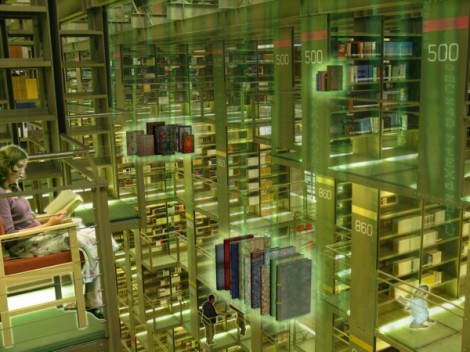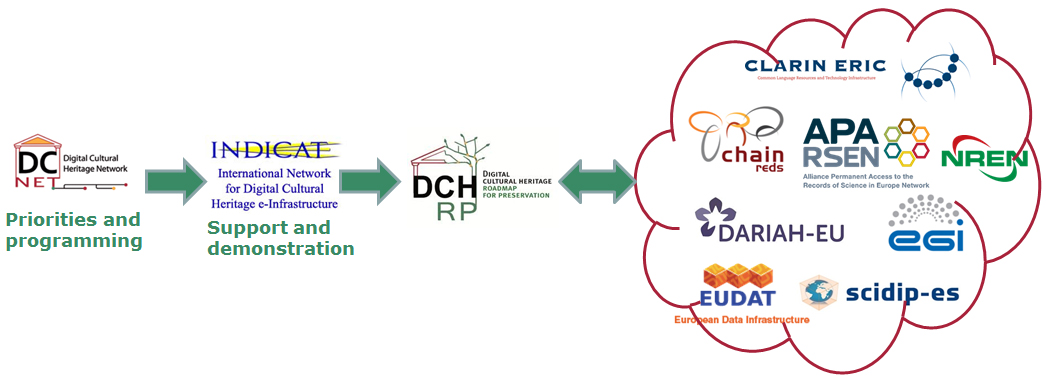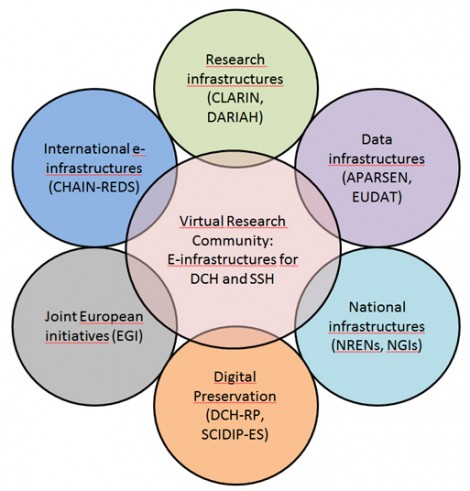eInfrastructures and Digital Libraries…
the Future

 The result of the digitisation initiatives carried out by memory institutions (museums, libraries, archives) in Europe and world-wide has produced a large amount of cultural content, which is continuously growing. The result of the digitisation initiatives carried out by memory institutions (museums, libraries, archives) in Europe and world-wide has produced a large amount of cultural content, which is continuously growing.
The existing services – e.g. the metadata aggregators, such as Europeana and the national cultural portals -, even if important to mobilise attention and resources on the general theme of the digitisation of cultural heritage, have limitations that do not allow to unlock the whole of this potential. On the other hand, the research infrastructures (e.g. DARIAH) are currently missing most of the cultural heritage data, including the data that are hold by local institutions.
The idea of a digital cultural heritage e-infrastructure is to set-up a "common pot", where institutions can deliver safely their content, which can be seen as a “continuum” by the users. Further, the content that are ready to be open can then be used to develop and demonstrate use cases to encourage more institutions (both national and local one, also small institutions) to adhere to the initiative.

The digital cultural heritage content is made of several different kinds of information: data (2D images and 3D models), metadata, publications, digital exhibitions, virtual reconstructions.
Even if growing very rapidly, the actual size of this content, if measured in byte, is still very much smaller than the amount of data produced by the experiments and the observations of the “hard sciences”.
However, its value is very much high, also because the content related to the digital cultural heritage is produced with a very intensive human work, which makes it expensive and unique. Therefore, preservation has the highest priority for the digital cultural heritage domain and the e-infrastructure services envisaged for cultural heritage and humanities should include preservation features, ranging from long-term to short-term storage. In addition to the storage resources, also the computing resources of the research e-infrastructures (both grid and cloud) can serve the preservation needs. An interesting experiment is the use of the grid to perform regular check-sum test, to monitor any damage or corruption to the data.
Further, the digital cultural heritage content is composed by information that is strongly linked. For example, the individual cultural object needs to be studied with respect to its context (that is made of information possibly coming from different data bases) and in the frame of the collections it belongs to. The improvement of the search technologies, in particular the application of semantic technologies, is very promising in this field. More generally, the linked (open) data movement is very much discussed in the cultural sector as a frontier to be reached to empower the digital cultural content with more links. Features to manage semantic search and linked open data are necessary components of the digital cultural heritage e-infrastructure.
 Even if not strictly a technological matter, the issue of openness of digital cultural content is another main challenge that the sector is approaching when moving online. To this regard, it should also be noted that the digital cultural heritage content is of great interest for many different targets: the research (both humanities and other sciences, e.g. archival data are currently offered for investigation to medical researchers and economists), educational products and the creative industries. Often, the partnerships for the exploitation of cultural data (both use and re-use of data) see public and private organisations working together, with the need to combine commercial and not-for-profit approaches. For this reason, digital cultural content needs to be accessed differently by each target, and therefore, authentication and authorisation mechanisms are important to be put in place efficiently by the e-infrastructure. Even if not strictly a technological matter, the issue of openness of digital cultural content is another main challenge that the sector is approaching when moving online. To this regard, it should also be noted that the digital cultural heritage content is of great interest for many different targets: the research (both humanities and other sciences, e.g. archival data are currently offered for investigation to medical researchers and economists), educational products and the creative industries. Often, the partnerships for the exploitation of cultural data (both use and re-use of data) see public and private organisations working together, with the need to combine commercial and not-for-profit approaches. For this reason, digital cultural content needs to be accessed differently by each target, and therefore, authentication and authorisation mechanisms are important to be put in place efficiently by the e-infrastructure.

For more information:
- download the presentation made by Antonella Fresa and Rosette Vandenbroucke at the EGI Technical Forum 2013 in Madrid;
- download the background note of the e-Infrastructures panel at TPDL 2013
- download all the presentations made during the e-Infrastuctures panel at TPDL 2013 (archive file RAR, 8 Mb) or download the single presentations below:
- DCH-RP by Antonella Fresa@TPDL2013
- EGI-InSPIRE-by Michel Drescher@TPDL2013
- eInfrastructure - the Cultural Heritage perspective by Nick Poole@TPDL2013
- eInfrastructure & DL by Matthias Hemmje@TPDL2013
- OpenAIRE by Yannis Ioannidis@TPDL2013
- The CHAIN-REDSProgramme on Data Infrastructures by Roberto Barbera@TPDL2013
- Towards a pan-European Collaborative Data Infrastructure by Norbert Meyer@TPDL2013
|